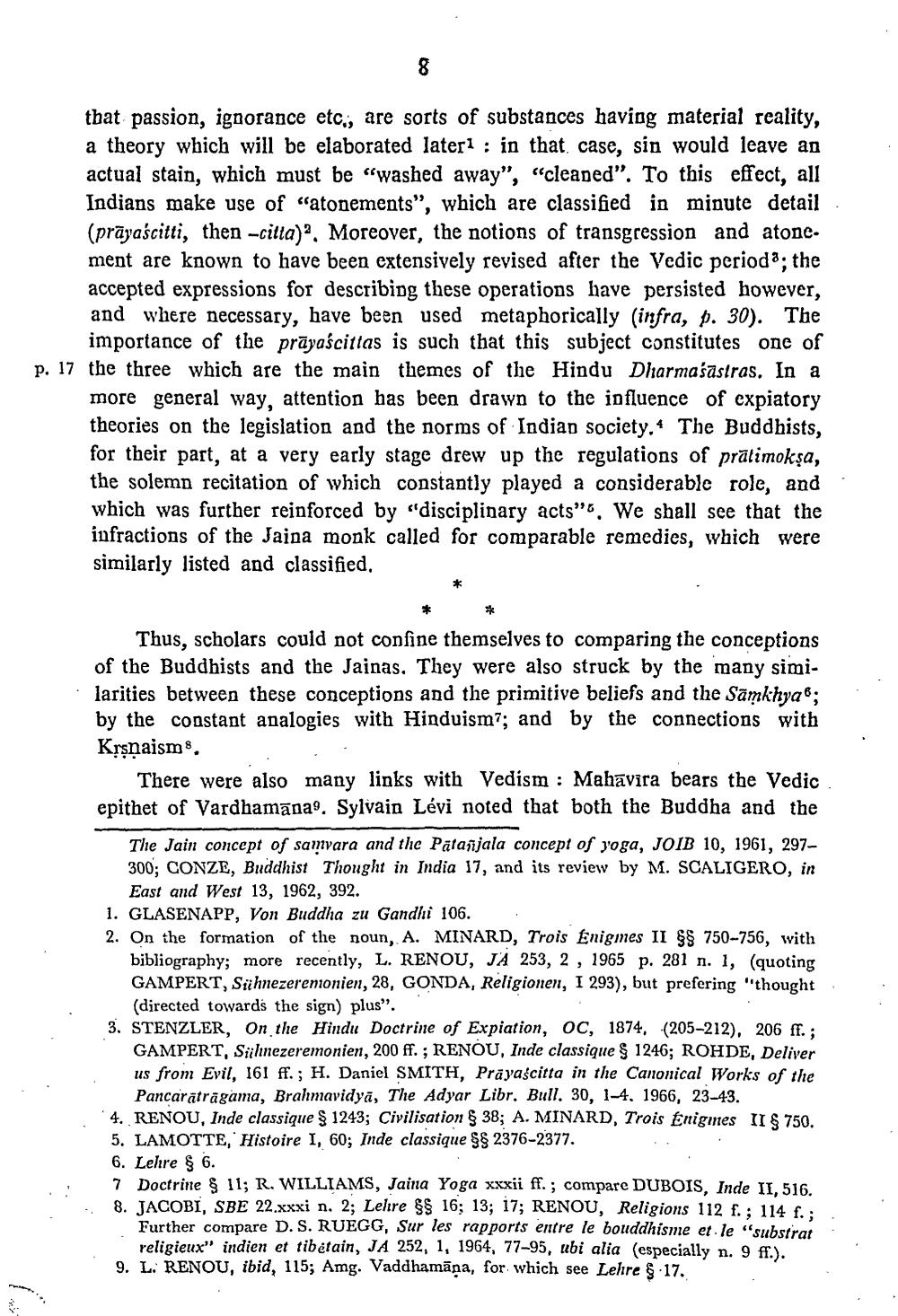________________
that passion, ignorance etc.; are sorts of substances having material reality, a theory which will be elaborated later1 ; in that case, sin would leave an actual stain, which must be washed away", "cleaned". To this effect, all Indians make use of “atonements", which are classified in minute detail (prāyascitti, then -citta). Moreover, the notions of transgression and atone. ment are known to have been extensively revised after the Vedic period 8; the accepted expressions for describing these operations have persisted however, and where necessary, have been used metaphorically (infra, p. 30). The importance of the prāyaścitias is such that this subject constitutes one of
which are the main themes of the Hindu Dharmaśāstras. In a more general way, attention has been drawn to the influence of expiatory theories on the legislation and the norms of Indian society. 4 The Buddhists, for their part, at a very early stage drew up the regulations of prātimokşa, the solemn recitation of which constantly played a considerable role, and which was further reinforced by “disciplinary acts". We shall see that the infractions of the Jaina monk called for comparable remedies, which were similarly listed and classified,
p. 17 the the
Thus, scholars could not confine themselves to comparing the conceptions of the Buddhists and the Jainas. They were also struck by the many similarities between these conceptions and the primitive beliefs and the Samkhya: by the constant analogies with Hinduism7; and by the connections with Krsnaism
There were also many links with Vedism : Mahavira bears the Vedic epithet of Vardhamana9. Sylvain Lévi noted that both the Buddha and the
The Jain concept of samvara and the Patanjala concept of yoga, JOIB 10, 1961, 297– 300; CONZE, Buddhist Thought in India 17, and its review by M. SCALIGERO, in
East and West 13, 1962, 392. 1. GLASENAPP, Von Buddha zu Gandhi 106. 2. On the formation of the noun, A. MINARD, Trois Énigmes II SS 750-756, with
bibliography; more recently, L. RENOU, JA 253, 2, 1965 p. 281 n. 1, (quoting GAMPERT, Sühnezeremonien, 28, GONDA, Religionen, I 293), but prefering "thought
(directed towards the sign) plus". 3. STENZLER, On the Hindu Doctrine of Expiation, OC, 1874, (205-212). 206 ff.;
GAMPERT, Sühnezeremonien, 200 ff. ; RENOU, Inde classique $ 1246; ROHDE, Deliver us from Evil, 161 ff.; H. Daniel SMITH, Prayascitta in the Canonical Works of the
Pancaratrāgama, Brahmavidyā, The Adyar Libr. Bull. 30, 1-4, 1966, 23-43. 4. RENOU, Inde classique $ 1243; Civilisation § 38; A. MINARD, Trois Énigmes II $ 750. 5. LAMOTTE, Histoire I, 60; Inde classique $8 2376-2377. 6. Lehre $ 6. 7 Doctrine § 11; R. WILLIAMS, Jaina Yoga xxxii ff.; compare DUBOIS, Inde II, 516. 8. JACOBI, SBE 22.xxxi n. 2; Leltre SS 16; 13; 17; RENOU, Religions 112 f. : 114 f.:
Further compare D. S. RUEGG, Sur les rapports entre le bouddhisme et le "substrat.
religieux" indien et tibétain, JA 252, 1, 1964, 77-95, ubi alia (especially n. 9 ff.). 9. L. RENOU, ibid, 115; Amg. Vaddhamāna, for which see Lehre $.17.




